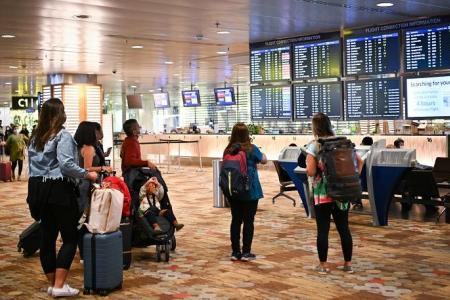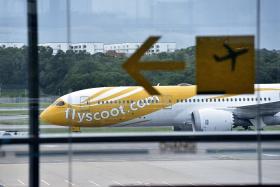Changi Airport fifth-busiest international airport in 2023; S’pore-KL the busiest flight route
Changi Airport has been ranked the fifth-busiest international airport in the world in 2023 by airline seat capacity, with the one-hour flight between Singapore and Kuala Lumpur topping the list for the world’s busiest international route.
The Jakarta-Singapore and Bangkok-Singapore routes were also among the world’s busiest, coming in at seventh and ninth on the list of the top 10 international routes, respectively.
These rankings were released by global travel data provider OAG Aviation on Dec 21 and compiled using information on scheduled airline seats.
In all, seven of the world’s top 10 busiest international routes were in Asia-Pacific, a sign of the rapid recovery that the region has made over the past year after lagging behind the rest of the world due to its delayed reopening after the pandemic.
According to OAG, Changi Airport had a total international seat capacity of 36.1 million in 2023.
This is 66 per cent higher than the 21.7 million seats in 2022 when it was ranked eighth in OAG’s charts for international airports, but 15 per cent short of the 42.5 million scheduled seats in 2019, when the airport was the world’s fourth busiest before Covid-19 struck.
Dubai International Airport held on to the title of the world’s busiest international airport in 2023 with 56.5 million scheduled seats. It was the busiest international airport by seat capacity in 2022 and 2019 as well.
London’s Heathrow Airport came in second in 2023 with 46.5 million seats, followed by Amsterdam’s Schiphol Airport with 37.2 million.
The only other international airport in the Asia-Pacific to make the top 10 was Incheon Airport in Seoul, South Korea, ranking seventh with 33.7 million seats.
For international flight routes, the Kuala Lumpur-Singapore route had 4.89 million scheduled seats in 2023 – a 50 per cent increase from 2022, but still 12 per cent shy of 2019 numbers.
The Jakarta-Singapore route had 3.91 million scheduled seats in 2023, 81 per cent higher than 2022 but 29 per cent lower than 2019.
Meanwhile, Bangkok-Singapore had 3.48 million seats in 2023, up 47 per cent from 2022, but down 9 per cent as compared with 2019.
Mr Mayur Patel, head of Asia at OAG, said travel recovery in the Asia-Pacific region in 2023 has been a story of two halves.
As South Asia, South-east Asia and Australasia opened up first, airports there were able to scale up capacity much faster than their counterparts in North-east Asia, which are now catching up.
It is a similar story for Changi Airport, which had a head start compared with its regional peers.
But the pace of recovery here has slowed, and this can be attributed to the sluggish return of tourists from mainland China, he added.
In comparison, the Middle Eastern hubs in Dubai and Doha, which are less reliant on markets like China, have recovered fully and are now at 5 to 6 per cent above their 2019 seat capacity.
Mr Patel highlighted Hong Kong, which was Asia-Pacific’s busiest international airport in 2019, as one to watch, noting that the territory, which was among the last to reopen, has been rapidly rebuilding capacity with the aim of a full recovery by end-2024.
He said: “Keeping in mind that Hong Kong retains the world’s largest cargo hub, and with strong growth continuing into 2024, its passenger capacity will take a lead over other Asian hubs.”
Mr Patel expects to see more international flight routes to and from Hong Kong to make the top 10 list in 2024.
In the last three months of 2023, the Hong Kong-Taipei route has already overtaken Singapore-Kuala Lumpur as the world’s busiest international flight.
Closer to home, Mr Patel noted that the Jakarta-Singapore route had dropped from third place in 2019 to seventh in 2023. He said the reason for this is that Singapore Airlines has so far only been granted about two-thirds of the flight frequency it had with the Indonesian capital in 2019.
The final stage of Changi Airport’s recovery will depend on whether it can fill these gaps, Mr Patel added.
In addition, an uncertain macroeconomic outlook, geopolitical risks and a resurgence in Covid-19 infections could dampen demand and lead to the scaling back of capacity growth, he said.
Mr Lim Ching Kiat, executive vice-president for air hub and cargo development at Changi Airport Group, said the airport is hopeful of making a full recovery in 2024, both in terms of connectivity and passenger traffic.
New services that will start include non-stop flights between Singapore and Brussels by Singapore Airlines from April 2024, and Air Canada’s direct flights between Singapore and Vancouver, which will also take off from April 2024.
Said Mr Lim: “2023 has been an exciting year for Changi Airport, as we witnessed the strong growth of passenger traffic across many regions in the world, and welcomed passengers to the newly upgraded Terminal 2.”
He added: “With travel demand on an uptrend, we will continue to work closely with our airline partners to launch new routes and bring new destinations and experiences to travellers. For the routes which we are seeing strong demand and high passenger loads, we will work with airline partners to bring in more air capacity.”
Get The New Paper on your phone with the free TNP app. Download from the Apple App Store or Google Play Store now


